
Dendrobium is a genus of mostly epiphytic and lithophytic orchids in the family Orchidaceae. It is a very large genus, containing more than 1,800 species that are found in diverse habitats throughout much of south, east and southeast Asia, including China, Japan, India, the Philippines, Indonesia, Australia, New Guinea, Vietnam and many of the islands of the Pacific. Orchids in this genus have roots that creep over the surface of trees or rocks, rarely having their roots in soil. Up to six leaves develop in a tuft at the tip of a shoot and from one to a large number of flowers are arranged along an unbranched flowering stem. Several attempts have been made to separate Dendrobium into smaller genera, but most have not been accepted by the World Checklist of Selected Plant Families.

Dendrobium crumenatum, commonly called pigeon orchid, or 木石斛 is an epiphytic orchid in the family Orchidaceae and is native to Asia, Southeast Asia, New Guinea and Christmas Island. It has two rows of leaves along its pseudobulb and relatively large but short-lived, strongly scented white flowers. It usually grows in exposed positions in lowland rainforest and coastal scrub.

Johannes Jacobus Smith was a Dutch botanist who, between years 1905 to 1924, crossed the islands of the Dutch East Indies, collecting specimens of plants and describing and cataloguing the flora of these islands. The standard botanical author abbreviation J.J.Sm. is applied to plants described by J.J. Smith.

Dendrobium cuthbertsonii is a species of orchid in the genus Dendrobium. It grows epiphytically at up to 10,000 feet (3,000 m) above sea level in New Guinea and the Bismarck Archipelago. It is targeted by commercial collectors who harvest it for export. It has one of the longest floral durations of any orchid, with individual flowers remaining open for up to nine months. Another source says ten months. Its stems are 1–2 centimetres (0.4–0.8 in) tall and 4–7 millimetres (0.16–0.28 in) wide; the flowers are 25–40 mm (1.0–1.6 in) long, 13–35 mm (0.5–1.4 in) wide, and extremely variable in colour., ranging from crimson through orangey-red.

Dendrobium antennatum, commonly known as the green antelope orchid, is an epiphytic orchid in the family Orchidaceae. It has cylindrical pseudobulbs with up to twelve leaves near their tips and up to fifteen white flowers with green petals and a white labellum with purple stripes. It grows in New Guinea and in tropical North Queensland where it is rare.

Dendrobium bigibbum, commonly known as the Cooktown orchid or mauve butterfly orchid, is an epiphytic or lithophytic orchid in the family Orchidaceae. It has cylindrical pseudobulbs, each with between three and five green or purplish leaves and arching flowering stems with up to twenty, usually lilac-purple flowers. It occurs in tropical North Queensland, Australia and New Guinea.

Dendrobium discolor, commonly known as antler orchid or golden orchid, is a species of epiphytic or lithophytic orchid in the family Orchidaceae, and are native to northern Australia, New Guinea, and part of Indonesia. It has cylindrical pseudobulbs, each with between ten and thirty five leathery leaves, and flowering stems with up to forty mostly brownish or greenish flowers with wavy and twisted sepals and petals.
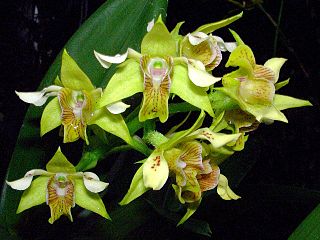
Dendrobium macrophyllum, commonly known as the large-leaved dendrobium or pastor's orchid, is a species of Orchid.
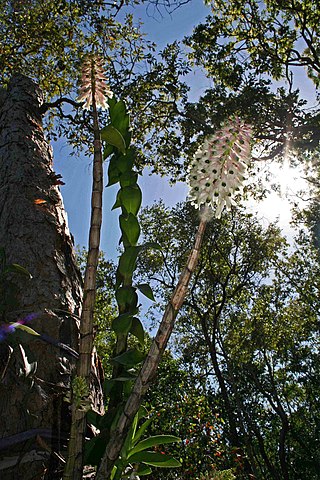
Dendrobium smillieae, commonly known as the bottlebrush orchid, is an epiphytic or lithophytic orchid with large, spongy pseudobulbs, thin, bright green leaves which are shed after their first year and crowded flowers in a bottlebrush-like arrangement. The flowers are white, to cream-coloured or pink and the labellum has a shiny, dark green tip. This orchid species is found in some of the Torres Strait Islands, and through Cape York Peninsula to Townsville, Queensland. It is also found in New Guinea and eastern Indonesia.
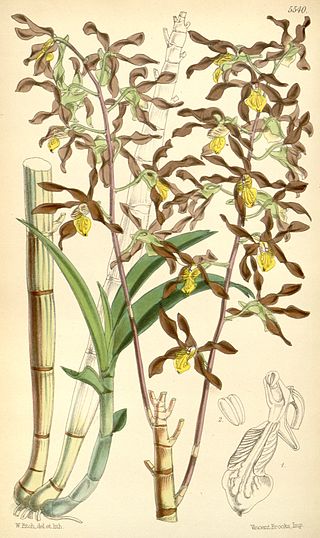
Dendrobium johannis, commonly known as the chocolate tea tree orchid, is a species of epiphytic or lithophytic orchid native to Australia and New Guinea. It has spindle-shaped pseudobulbs, between five and ten dark green leaves with purplish markings and flowering stems with up to fifteen chocolate brown flowers with a yellow labellum.

Dendrobium trilamellatum, commonly known as the fragrant tea tree orchid or large tea tree orchid, is a species of epiphytic orchid found in northern Australia and New Guinea. It has spindle-shaped pseudobulbs, between three and seven leathery, dark green leaves and between three and fifteen yellow, yellowish brown or brown flowers with a mauve to purple labellum.
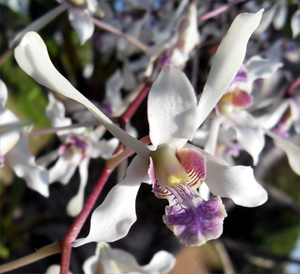
Dendrobium lineale is a species of orchid. It is an epiphytic plant that grows along the north-eastern coast of New Guinea, from Milne Bay to just over the border into the Indonesian Province of Papua, and from sea level to around 800 metres (2,600 ft). It has cane-like pseudobulbs which grow up to 2 metres long and 2–3 centimetres (0.8–1.2 in) in diameter. Its inflorescences are up to 75 cm (30 in) long with many flowers, up to 5 cm (2.0 in) across. Its leaves are oblong or lanceolate, and up to 15 cm (6 in) long. They last two to three months and bloom throughout the year in the native habitat.
Dendrobium macfarlanei, commonly known as the coastal shaggy orchid, is an epiphytic orchid in the family Orchidaceae. It has a very short rhizome with crowded, slender stems with most of the leaves in the lower half. The leaves are flattened and pointed, the flowers small and pale greenish cream-coloured. It occurs on islands in the Torres Strait and in New Guinea.
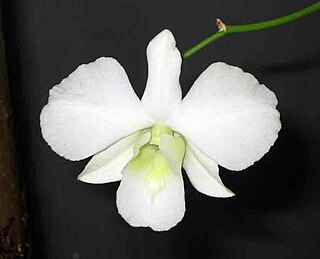
Dendrobium section Phalaenanthe is a section of the genus Dendrobium.

Dendrobium section Aporum is a section of the genus Dendrobium.

Dendrobium section Calyptrochilus is a section of the genus Dendrobium.
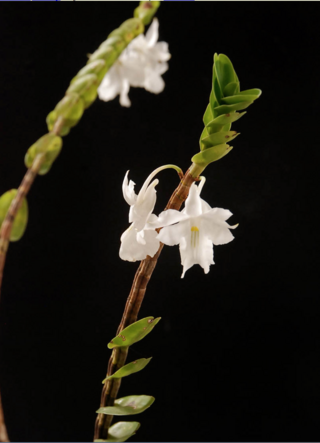
Dendrobium section Distichophyllae is a section of the genus Dendrobium.

Dendrobium section Dendrobium is a section of the genus Dendrobium.

Dendrobium section Rhizobium is a section of the genus Dendrobium.

Dendrobium section Platycaulon is a section of the genus Dendrobium.




















